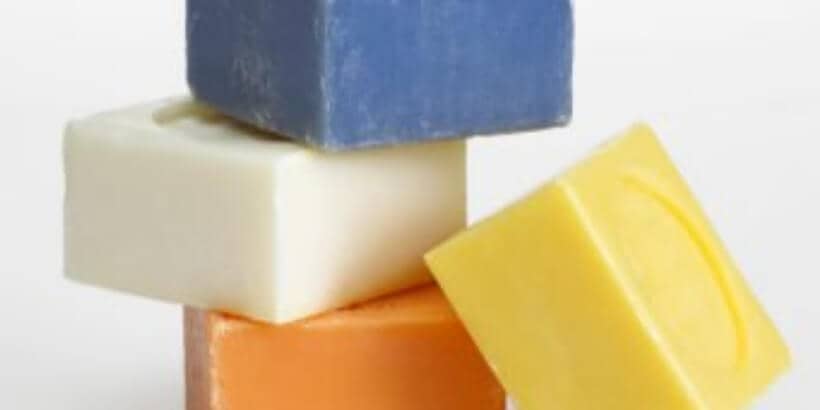Replace Your Soap with Soapy Plants

Sick of chemical-filled soaps that leave your hands feeling dirtier than before you washed them? Then we’ve got the project for you! Do it yourself soap with soapy plants! It’s as simple as adding water.
The following project is from When Technology Fails by Matthew Stein. It has been adapted for the web.
There is something inherently satisfying about making soap. Maybe it relates to the 4,500+ year history of human soap making; maybe it simply reflects a desire to keep the jungle at bay and put our stamp on our personal environment. For pioneer women, soap making was an annual event, often lasting for days while lye was leached from wood ashes saved from the winter fires and then cooked with fat as the spring thaw began.
—Dr. Robert S. McDaniel, Essentially Soap
Soaps and detergents are both known as surfactants. Surfactants reduce the surface tension of water, causing the water to fully wet both the object to be cleaned and the debris, encouraging the debris to wash away. According to Susan Miller Cavitch, author of The Soapmaker’s Companion, soap molecules also have a distinct head and tail, one end having an attraction to water and the other end having an attraction to dirt. This property helps soap molecules to connect the dirt to the water, further enabling the water to wash away the dirt.
Soapy Plants
There are a number of plants that can be used as a substitute for soap without any chemical processing. These plants contain naturally occurring soap-like substances, called saponins. Bouncing bet (also called soapwort), clematis, and yucca are three common North American plants with significant saponin content. It has been said that Native Americans bathed regularly and were often appalled by the smell of white pioneer men. To use any of these plants for soap, chop up the appropriate part of the plant and rub it between your hands with some water or dry it for future use. Before trying a full dose on your body, test for allergic reactions by rubbing a bit onto the inside of your wrist and waiting one day to make sure there is no adverse reaction. Because saponins are somewhat poisonous, and Native Americans have used them to paralyze fish, you do not want to eat these plants, except perhaps for the edible fruits and flowers of the yucca family (Brill 1994, 134).
Bouncing Bet

Figure 14-1. Bouncing bet. Illustration courtesy of Earth Knack: Stone Age Skills for the 21st Century by Bart and Robin Blankenship (Gibbs Smith, 1996).
Do not use bouncing bet on your face, because it is very irritating to the eyes. Collect bouncing bet in the late summer to fall. Found nationwide, it is easiest to identify by its pretty white or pink flowers with five petals. You can use the entire plant (Blankenship and Blankenship 1996,142).
Clematis

Figure 14-2. Clematis. Illustration courtesy of Earth Knack: Stone Age Skills for the 21st Century by Bart and Robin Blankenship (Gibbs Smith, 1996).
Clematis is a common climbing vine with white or purple flowers, and is often found dominating the tops of trees. Collect the leaves and flowers for use as soap (Blankenship and Blankenship 1996,142).
YUCCA, AGAVE, SPANISH BAYONET, SOTOL, AND JOSHUA TREE

Figure 14-3. Yucca. Illustration courtesy of Earth Knack: Stone Age Skills for the 21st Century by Bart and Robin Blankenship (Gibbs Smith, 1996).
These traditional desert-dwelling plants also contain saponins. The root contains the most saponins, but use of the root kills the plant, so please don’t use this plant frivolously. If you are pounding and soaking the leaves for fiber to make cordage, the soaking water will contain sufficient saponins for bathing (Blankenship and Blankenship 1996,143).
Recommended Reads
Everything You Need for a Grab-n-Go Survival Kit: Prepping 101
Recent Articles
The Garlic Clove! This small crop adds a big punch of flavor that complements almost every delicious dish you could think of. And the best part? These two recipes are a breeze to make together!
Read MoreOur love affair with amaranth began long before the pseudo-grain became a trendy staple for gluten-free folk. The luscious leaves of this annual plant are not only packed with a plethora of health benefits.
Read MoreAside from the sheer pleasure of telling your friends, straight-faced, that you maintain your garden using something called a “chicken tractor,” there are a slew of other benefits to working the land with a few of your animal friends. Getting rid of pests without chemicals, for one; letting them do the work of weeding and…
Read MoreIf the idea of running a vegetable farm sounds daunting, you’re not alone. What can you do to simplify techniques and reduce expenses? Where do you even begin?
Read MoreDon’t know where to start for foraging wild plants? Read on for the information you need to begin foraging on your own: where to do it and how to be safe.
Read More








